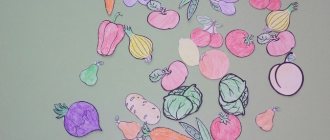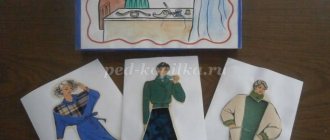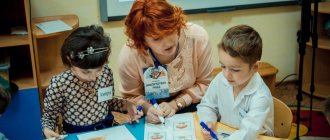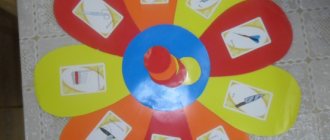Geometric puzzle games are very useful for developing children's spatial concepts, constructive thinking, logic, imagination and intelligence. One of these games is the ancient Chinese game TANGRAM. She was born in China 3000 years ago. From the 7 elements into which the square is divided, you can create many different objects and animal figures.
Tangram. History of origin.
This famous puzzle comes from China. According to legend, it was invented by the teachers of the emperor’s son - a mathematician, artist and philosopher. With the help of an exciting game, they taught the lazy heir calculations and combinatorial thinking. They taught us to comprehend the beauty of images and to understand the complex world through simple figures. The puzzle is a square of seven geometric shapes. By moving and arranging the figures, you can come up with more than 6 million compositions. In China it is called “chi-chao-tu”. Translated as “seven planks of skill” or “pattern of seven smart parts.” In Europe, tangrams were made from expensive wood and ivory. Many historical celebrities were fond of it, such as Napoleon Bonaparte, Thomas Hill, Lewis Carroll.
Before the advent of computers and various electronic games, tangram was popular along with chess and dominoes. Currently, tangram is more often used in children's educational institutions for the development of children.
Perelman approved
Mathematician and popularizer of science Yakov Perelman considered entertainment to be the main means of explaining scientific facts to the uninitiated. Surprise him, arouse curiosity, activate thinking and observation.
Tangram is just such a way to involve a child in the world of mathematics and its laws. The game helps children understand the fact that completely different shapes made up of seven parts of a square have the same area as the original square. But the perimeters of the figures are different1. Why not visual material for elementary school lessons?
Tangram game for preschoolers: goals and objectives
Tangram develops many abilities. One of the goals of the tangram is to teach children to independently find solutions. By putting the figures in one order or another, preschoolers try different options, choosing the optimal composition in accordance with the given rules. The magic square, like other logical tasks and puzzles, perfectly activates mental activity and develops character.
Tasks:
- To develop in children memory, attention, fine motor skills, various types of thinking (logical, spatial, imaginative, constructive), intelligence, imagination,
- To develop children's perception of color and shape,
- Teach to follow instructions and play according to given rules,
- To develop perseverance and patience as necessary qualities for the future school period,
- To instill in children responsibility and a serious attitude towards completing the assigned task.
Benefits for children
Despite its apparent primitiveness, tangrams are often called fitness for the brain - albeit not for adults, but for older kindergarten students and younger schoolchildren. As is often the case with educational games, the main and primary task of the tangram is to force the child to strain his thinking while solving some problem, because this is the only way to “pump up” mental abilities. In the meantime, tangram has a positive effect on the overall mindset and allows you to achieve the goal of developing the following skills.
- Ability to play by the rules . Probably the basic skill with which to begin learning tangram, and, perhaps, any games in general. Many modern children probably notice that any dissatisfaction provokes increased attention from their parents, a desire to please the crying person and calm him down. It is important for kids to learn that not all rules are set by their parents, and sometimes you need to give in to the demands of the rules.
At what age do they play tangram?
There are many opinions, successful and unsuccessful experiences of teaching geometric puzzles to children of different ages. Often, preschoolers 2.5 years old do not yet understand the rules of the game. Children 3-4 years old are quite capable of moving and folding figures, but they do not always have enough perseverance. As a rule, it ends with 2-3 compositions under the guidance of a teacher or mother, then a switch of attention and types of activities is required. But the most diligent children of 3.5 - 4 years old can already come up with images themselves or assemble them according to existing patterns. And if you interest them not just in composing figures, but in making a multi-colored tangram, and organically interweave a fairy tale, a narrative with elements of adventure and vivid images during the lesson, then preschoolers can independently come up with unexpected solutions to the puzzle.
At what age does a child start playing tangram? Each teacher or parent decides for himself. Children may master it very early, or may not show interest even in older preschool age. The child should be ready for puzzles of this kind.
The teacher should take into account that if the activity involves making a tangram with their own hands, then the children must be able to work with scissors.
Cutting template
For ease of use, we will take the black and white version. It is convenient to print it or draw it yourself. It is better to do this on thick paper or cardboard. Then the square must be carefully cut along the lines.
To begin, ask your child to make a square out of these pieces. It is better if the child completes the task without looking at the drawing of the square. But if it doesn’t work out, then of course you can use the sample.
A variety of silhouettes are created from tangram elements. It is easier for a child to do this using samples with drawn components. Outline patterns are more difficult to reproduce.
Tangram: a fairy tale with tasks
The most interesting option for a lesson with a magic square for children would be an activity in the form of a fairy tale. You can choose any fairy tale in accordance with the age interests of preschoolers.
Take, for example, the cartoon “The Adventures of Luntik and His Friends.” All of his characters are well known to preschoolers. You can invite them to collect the image of the main character - Luntik, Baba Kapa, General Sher, Kuzya, Bee, Vupsen and Pupsen, the toad Klava and others.
As a rule, all children remember the beginning of the fairy tale: “Once upon a time, a baby was born on the Moon...”. Further, in accordance with the plot of the selected series, the heroes can meet in a flower meadow (collect a flower), play a ball (collect a ball), sit at the table and drink tea with pie (collect a table, then dishes, pie...).
In accordance with the age characteristics and interests of preschoolers, the teacher can complicate the lesson by introducing a competitive element: boys collect male characters - Luntik, Kuzya, the spider Shnyuk, and girls - female characters - Mila, Baba Kapa, butterflies, toad Klava, leech, etc. .
You can also watch one of your favorite cartoon series with the kids and together choose images of characters and objects to compose them from tangram figures.
When offering tangram tasks to children, it is important for the teacher to remind preschoolers to follow the rules of the game.
The tangram game perfectly develops intelligence, imagination, logical thinking, and teaches the basics of geometry. The tangram game is undoubtedly useful for preschoolers.
Buy on Aliexpress
Buy on Aliexpress
Buy on Aliexpress
If you found the information on the site useful, please share it on social networks:
Brief history of the technique
Legend has it that a certain Chinese emperor began to use the tangram for the first time, who was very worried that his future heir did not show due interest in the learning process. Then the monarch called for help from three wise men - a mathematician, an artist and a philosopher, who together came up with the magic square. Thanks to it, you can perform a huge number of tasks. And the capricious prince finally began to study.
It is known that even Napoleon at one time was engaged in folding tangram figures.
Read also: Nothing works and no one cares / Sudo Null IT News
MAGAZINE Preschooler.RF
Mathematical game TangramIntroduction:
I heard about an ancient Chinese game - the tangram puzzle. I was very interested in this game. And I wanted to learn as much as possible about the tangram. I decided to study in detail the history of this puzzle and explore the possibilities of this game, its application in the form of a game. Each of us knows from childhood what a game is. Sometimes you can find something unusual and exciting in the simplest game. In the game we learn, avoid problems, strive for results (even small ones, noticeable only to us). Games not only occupy leisure time, but also educate. Our modern world is full of technical innovations. Our way of life has been modernized, human robots have learned to think and decide, and sometimes replace people themselves. The world around is becoming technical, and spiritual warmth is gradually disappearing into oblivion. Sometimes you can find something unusual and exciting in the simplest things, even in an ordinary game. Do you know what a secret, task, logic is? Puzzle - this is all that one very old game includes...
Relevance
Puzzles are toys for all times. Before the advent of computer games and the rapid development of board games, one of the main entertainments for most people was a puzzle game. And nowadays, a lot of people are interested in puzzles. They are loved not only by children, but also by adults. The game helps develop logical thinking and geometric intuition. This is a way of distracting from everyday problems, at the same time it is aimed at developing various thought processes - comparison, generalization, establishing a sequence, determining the relationship “whole” - “part” .
What is tangram?
Tangram is perhaps the most popular game from the series of so-called “geometric constructors” .
Tangram is an ancient Chinese puzzle consisting of seven flat figures that are folded in a certain way to form another, more complex figure (representing a person, animal, household item, etc.). The figure that needs to be obtained is usually specified in the form of a silhouette or an external contour. When solving the puzzle, two conditions must be met: first, you must use all seven tangram shapes, and second, the shapes must not overlap each other.
Goal: To teach children to make geometric shapes of animals, birds, people, architectural structures, and transport.
Tasks: Build simple shapes: square, triangle, rectangle, according to given parameters. Development of cognitive interest, fine motor skills, memory, attention, visual imaginative thinking. Cultivating accuracy and politeness in individual and joint activities.
Hypothesis: if a person becomes interested in the magical game Tangram, then he not only expands his intellectual horizons, but also develops thinking, imagination, and visual memory.
Origin story
The origin of the word “tangram” is not known for certain. Here are the versions we were able to find about the meaning of this word.
In China, the name Tangram is unknown, but the game is called Shi-Chao-Tyu (seven cunning figures).
In the Oxford English Dictionary, the name Tangram appears with reference to the authoritative Henry E. Dudeny, his version was adopted by the compiler of the dictionary D. Murray. He discovered that the word tangram was first found in the 1864 edition of Webster's dictionary. According to Murray, the word tangram itself was coined in the middle of the last century by an American who formed a neologism from the word Tan, which means Chinese in Cantonese, and the common suffix -gram (as in anagram or cryptogram).
A different theory of the origin of the word tangram was put forward by Peter Van Note in the preface to the new edition of Lloyd's book: Chinese families living on boats are called tanka.
In the book “Chinese Philosophical and Mathematical Transgram” (1817), the word transgram is interpreted as an old English word meaning a puzzle toy. At first, the puzzle was used not for entertainment, but for teaching geometry. The first image of a tangram (1780) was discovered in a woodcut by the Japanese artist Utomaro, where two girls fold figures.
Like the meaning of the word, the history of the appearance of this game has reached us only in legends.
Legend one: version about broken tiles
More than 4,000 thousand years ago, a porcelain tile fell out of one person’s hands and broke into seven pieces. Frustrated, he hurriedly tried to fold it, but each time he received new and interesting images. This activity turned out to be so fascinating that subsequently the square, made up of seven geometric figures, was called the Board of Wisdom.
Legend two: three wise men came up with “Shi-Chao-Tyu”
Almost two and a half thousand years ago, the middle-aged Emperor of China gave birth to a long-awaited son and heir. Years passed. The boy grew up healthy and smart beyond his years. One thing worried the old emperor: his son, the future ruler of a huge country, did not want to study. The boy found it more enjoyable to play with toys all day long. The emperor called to himself three wise men, one of whom was known as a mathematician, another became famous as an artist, and the third was a famous philosopher, and ordered them to come up with a game, by playing with which, his son would comprehend the principles of mathematics, learn to look at the world around him with the gaze of an artist , would become patient, like a true philosopher, and would understand that complex things are often made up of simple things. Three wise men came up with “Shi-Chao-Tyu” - a square cut into seven parts.
Legend Three: Seven Books of Tang
“In the notes of the late Professor Challenor, which fell into the hands of the author,” Loyd asserted, “there is information that seven books on tangrams, each containing exactly a thousand figures, were compiled in China more than 4000 years ago. These books have now become so rare that during the forty years that Professor Challenor spent in China, he only once managed to see the first edition of the first of seven volumes (preserved in its entirety) and several scattered fragments of the second volume . According to Loyd's legend, Tang was a legendary Chinese sage who was worshiped as a deity by his countrymen. He arranged the figures in his seven books according to the seven stages in the evolution of the Earth. His tangrams begin with symbolic images of chaos and the principle of "yin and yang" . Then follow the simplest forms of life, as we move along the evolutionary tree, figures of fish, birds, animals and humans appear. Along the way, in various places you come across images of what was created by man: tools, furniture, clothing and architectural structures. Loyd frequently quotes sayings from Confucius, a philosopher named Shufutse, commentator Li Huangzhang, and the fictional Professor Challenor. Li Huangzhang is mentioned because, according to legend, he knew all the figures from the seven books of Tang before he learned to speak. Loyd also contains references to “famous” Chinese proverbs such as “Only a fool would undertake to write the eighth book of Tang .
Yakov Isidorovich Perelman, a Russian scientist, popularizer of physics, mathematics and astronomy, dedicated one of his books “Puzzle Figures of 7 Pieces” published in 1927 to the tangram. The name of this remarkable person is associated with the emergence and development of a special – entertaining – genre of scientific popularization of the fundamentals of knowledge. The author of more than a hundred books and brochures, he had the rare gift of talking about dry scientific truths in an exciting and interesting way, arousing burning curiosity and inquisitiveness - these are the first stages of the independent work of the mind.
Here's what he writes: “You can not only make funny figures out of 7 pieces of a cut square. But also glean some information from geometry . For example, what is a square, quadrilateral, pentagon, give a definition of equal-sized figures.
Rules of the game
Tangram is one of the amazing puzzles that absolutely anyone can get carried away with. For mathematicians, this is an inexhaustible source of geometric relationships. Teachers often use it as a visual aid. You can make a tangram yourself; all you need is scissors, paper and a ruler.
The essence of the game is to construct various object silhouettes on a plane. The variety and varying degrees of complexity of geometric constructors allows us to take into account the age characteristics, inclinations, capabilities, and level of training of the player.
All assembled figures must have the same area because assembled from identical elements. This implies:
Rules of the game:
Each assembled figure must include all seven elements.
When composing figures, elements should not overlap each other.
The elements of the figures must be adjacent to one another.
You need to start by finding the location of the largest triangle.
When drawing up silhouettes, the teacher constantly reminds the children
that it is necessary to use all parts of the set, tightly attaching them to each other.
An adult can use some techniques that will help a preschooler
achieve the best results: propose analysis of the sample as a whole or
the most complex part of it, indicate the location of one or two figures
in the silhouette being compiled, start laying out, and then invite the child to finish
silhouette or, conversely, to complete what the child started. Should be constantly
confirm the correctness of the child’s train of thought and actions, encourage him
plan the progress of your work, discuss methods of laying out and results,
encourage the desire to complete the work started, overcoming difficulties in
achieving the goal, fulfilling the plan. Help for the child should
be tactful, encouraging independence, activity, perseverance, proactive actions leading to achieving results. Direct instructions
what and how to do, it is better to avoid. The following advice to children is appropriate: “Look (examine) the picture carefully. What figures is it made of? , “Try it again,
but in a different way”, “Remember how you posted last time and start the same way” ,
“Think well first, and then do it”.
The game “Tangram” arouses great interest in children, promotes the development of analytical, synthetic and planning activities, opens up new opportunities for improving sensory skills, developing creative, productive thinking, as well as moral and volitional qualities of the individual.
The result of the game is a flat silhouette image. It is conditional, schematic, but the image is easily guessed by the main characteristic features of the object:
its structure, proportional ratio of parts and shape.
Types of problems solved by tangram Variety of problem figures
- It is necessary to fold the figure according to the contour pattern.
- It is necessary to fold the figure according to the pattern using a solid fill.
- It is necessary to add up the silhouettes of recognizable objects with the greatest accuracy.
Then you can practice on your own, creating your own - the simplest images. Thus, one’s own imagination develops. You don’t have to dwell only on the constructive part of the game. It's fascinating to transfer the resulting silhouettes onto paper. You can draw, create and work out the background, come up with a plot. And successful compositions can be used to decorate the interior of a room or play area.
You can create a more complex double or triple tangram (for this, two or three sets of seven “tans” are used).
Making a tangram
To make tangrams, take thick cardboard and draw a square on it. Then line it so that you get the following shapes: 5 triangles (2 large, 1 medium and 2 small), a square and a parallelogram - 7 shapes in total. You can use the template provided below.
A tangram can also be made from plexiglass, a piece of linoleum and other available materials.
Modern puzzles - “folding”
The oldest surviving Russian puzzle of this type dates back to 1820. It consists of seven pieces of cardboard with task cards attached, where figures are drawn that need to be folded. The puzzle is stored in the largest in our country
| Next > |
Progress of the lesson:
Organizing time. Exercise “Travel on a Cloud”
Educator: Children, today we will have an unusual journey, and I will not be Anna Sergeevna, but the queen of all sciences - Mathematics. I want to invite you to my kingdom, where entertaining games and interesting tasks await us. Do you agree?
Music is turned on for relaxation.
Sit comfortably and close your eyes. Inhale and exhale deeply two to three times. I want to invite you on a journey on a cloud. Jump onto a white fluffy cloud that looks like a soft mountain of plump pillows. Feel how your legs, back, butt are comfortably located on this large cloudy pillow. Now the journey begins. The cloud slowly rises into the blue sky. Do you feel the wind blowing across your faces? Here, high in the sky, everything is calm and quiet. The cloud will take you now to my kingdom.
Open your eyes, I am very glad to see you in my kingdom, where numbers and figures live. And so that you don’t get bored, I have prepared a task for you.
Part I. Game exercise “Count the same amount”
.
The exercise is performed on a typesetting canvas.
The teacher asks the child to place 7 dogs on the top strip. After completing the task, he asks:
- How many dogs did you count?
- What number can be used to designate seven dogs?
- What number represents the number seven?
The teacher shows the number «7»
. Children find it in their place and trace it with their hand.
On the second page the child places as many cats as there are dogs on the first page.
- Why did you count so many cats? (because there are so many dogs on the front page)
On the third stripe there are as many cows as cats. (Same questions)
.
After completing the exercise, the teacher asks:
— What can you say about the number of dogs, cats and cows? (seven, equally)
The teacher summarizes: “Seven dogs, seven cats, seven cows, seven of all.”
. Then asks the children to show the corresponding number.
Part II. Working with handouts.
Children perform a similar task on three-line cards. 9 puppies are placed on the top strip, 9 kittens on the second strip, and 9 calves on the bottom strip.
-Guys, you and I counted domestic animals together, and now you, each of you, will independently count their babies. (independent completion of the task)
.
Finger game “Left – Right”
- Nice job. Don’t think that in my kingdom it’s so boring and you need to study all the time. I want you to relax and play with me. Do you mind?
The music of E. Zheleznova “Left - Right”
. Children play the game with the teacher.
Part III. Game exercise “Place it correctly”
-It's time to continue our journey. A new game for you.
The teacher looks at the board together with the children:
— What geometric figure does the board look like?
What does a rectangular board have? (Gestures sides and corners.)
The teacher invites the child to show the sides of the board and name them.
(Top side, bottom side, right side, left side)
.
The teacher shows and names the corners: “Upper right corner, lower left corner.
Place the red circle in the top right corner, the green circle in the bottom right corner, the yellow circle in the top left corner, and the blue circle in the bottom left corner. (Children take turns doing the task)
. In which corner did you place the red circle? In which corner is the green circle? Etc.
Part IV. Game exercise “Hide the dog behind the Christmas tree”
- Guys, I have a friend. Do you want to know who it is? Guess the riddle and you will understand everything:
He is fluffy and big-eyed,
He is long-eared and toothy.
Eats grass, carrots,
Having shown your dexterity -
The wooden floor in the cage was chewed off.
And he's not a bunny, he's a (rabbit)
.
- Now we need to hide the dogs behind the Christmas tree. Which Christmas tree do you think the biggest dog would hide behind? Which Christmas tree would the smallest dog hide behind? What kind of Christmas tree would a smaller dog hide behind? What kind of Christmas tree would a dog even smaller than the previous one hide behind? (for the Christmas tree, which is even smaller)
Children perform this exercise in turns and hide the dogs according to their size.
Part V Game "Tangram"
.
There is a sample on the board. The teacher offers to make a portrait of the rabbit to please him.
Part VI. Reflection.
It was very interesting for me to play with you in my kingdom. But now, unfortunately, I will have to return you to kindergarten. Sit down and close your eyes. Music plays for relaxation.
We visited a wonderful and magical kingdom. Now you are back on your cloud, and it is taking you back to your place in kindergarten. You feel completely calm and happy. Get off the cloud and thank it for giving you such a good ride. Now watch it slowly melt into the air. Stretch, straighten up and be cheerful, fresh and attentive again.
Then we started working with patterns for tangrams - numbers.
There is a piece of paper in front of the child, I read him a poem, then he begins to shade the outline of the number.
Schemes - numbers for tangrams for children
Schemes - numbers for tangrams for children
Schemes - numbers for tangrams for children
After the outline of the figure is ready, he begins to lay out the figure from the parts of the tangram.
Schemes - numbers for tangrams for children
Schemes - numbers for tangrams for children
Schemes - numbers for tangrams for children
Then we move on to the next number, read a poem about the number 1, shade the outline of the number and move on to the tangram.
Schemes - numbers for tangrams for children
Schemes - numbers for tangrams for children
Schemes - numbers for tangrams for children
Schemes - numbers for tangrams for children
Schemes - numbers for tangrams for children
Schemes - numbers for tangrams for children
Schemes - numbers for tangrams for children
So sequentially we laid out all the numbers from 0 to 9, and then moved on to sheets with diagrams of objects for applying tangrams .
This set of leaves also comes in 2 versions: color and outline, each leaf also has coloring and writing.
We chose 3 diagrams from the set: with a house, a rocket and an airplane, and the child laid them out from the details.
Schemes for tangrams for children
Schemes for tangrams for children
Schemes for tangrams for children
If you liked these leaflets - diagrams, then go to the website https://shop.amelica.com, where you will find many more useful educational materials for conducting activities with children at home, in kindergarten and early development schools.
And now a few more photos of how we laid out numbers from parts of the tangram. Good luck to you and your baby!
Schemes - numbers for tangrams for children
Schemes - numbers for tangrams for children
Schemes - numbers for tangrams for children
Schemes - numbers for tangrams for children
Schemes - numbers for tangrams for children
Schemes - numbers for tangrams for children
Schemes - numbers for tangrams for children
Schemes for tangrams for children
Schemes - numbers for tangrams for children
Schemes for tangrams for children
Schemes for tangrams for children
Variety of tasks
Tangram for preschoolers is a fun and useful activity that can be started from the age of 4-5. First, the kids get acquainted with a new set, study its elements, find a triangle according to their parents’ instructions, and show which one is big and which one is small. Next, adults print out the diagram in full size, asking the little ones to put the elements on the drawing. These can be houses, animals, birds, fish, a Christmas tree, a man.
Gradually, the tasks become more complicated, children are offered a hint diagram, which in size may no longer correspond to the real “dimensions” of the figures, and a task to fold something, for example a bird.
Children, as a rule, also become interested in the fact that from a specific number of elements several varieties of birds can be added.
To prevent preschoolers from getting bored, you should come up with a plot - for example, write a fairy tale about animals who would like to live in a house. In order for each of them to occupy their own “room”, you need to assemble the beast from puzzle elements. Next, preschoolers are offered the following scheme:
They make a cat, a hare, a horse, a fish, a duck, a dog. We can “plant” a spruce next to the house to make it beautiful (its diagram is also presented above). Finally, a man built a dwelling for the menagerie - his figure is also on the diagram.
Cat lovers can be invited to compose these animals from puzzle elements according to the following schemes:
The setting is something like this: today is cat day, let's try to collect as many different species as possible. Or another option: a cat came to visit us and told us a lot of new things about her relatives. Let's show her how we can collect cats.
Also very interesting are the houses, of which a huge variety can be made from tangram elements:
Together with the child, you should discuss what kind of house he would like to build, for example, for his pets, and then offer him to work. If something doesn’t work out, don’t be nervous and yell at your child, such an attitude will only destroy his desire to understand the secrets of the Chinese puzzle. It’s best to help, hold, praise for your efforts, then the result will come very soon.
Next, you should complicate the tasks by offering your child more complex schemes:
When working with tangram, it is important to use a playful element, to come up with fairy tales and exciting stories. Otherwise, the baby will quickly get bored and will study through force.
Therefore, it is better to tell him about the magic square, which, at the behest of the good sorceress, split into several fragments, from which literally anything can be created. But the sorceress needs an assistant, so the child is temporarily endowed with miraculous powers, and according to the magic book (drawings and diagrams), he will populate the fictional kingdom with various inhabitants, build houses, boats, Christmas trees, etc. there.
Tangram is a great mental workout that will help you have fun and reinforce useful skills. Among the huge number of schemes, you can find those that will appeal to every preschooler.
https://youtube.com/watch?v=0WDj1bA3Xqo
Categories
- Toy library (195) Indoor games (46)
- Outdoor games (39)
- Competitions (28)
- Folk (49)
- Educational games (37)
- Applique (43)
- origami 4-7 years (35)
- Master classes. Folk dolls. (69)
- Holiday scenarios (21)








